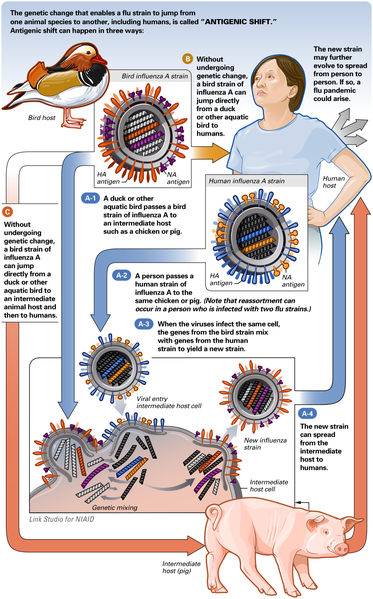2009 new emerging disease outbreak in Mexico and toward around the globe, this is happen when human's imune system seem so weak, so vulnerable against this tiny creature.

Influenza A virus subtype H1N1, also known as A(H1N1), is a subtype of influenzavirus A and the most common cause of influenza (flu) in humans. Some strains of H1N1 are endemic in humans, including the strain(s) responsible for the 1918 flu pandemic which killed 50–100 million people worldwide. Less virulent H1N1 strains still exist in the wild today, worldwide, causing a small fraction of all influenza-like illness and a large fraction of all seasonal influenza. H1N1 strains caused roughly half of all flu infections in 2006. Other strains of H1N1 are endemic in pigs and in birds.
In March and April 2009, hundreds of laboratory-confirmed infections and a number of deaths were caused by an outbreak of a new strain of H1N1.
2 May 2009. The situation continues to evolve. As of 18:00 GMT+1, 2 May 2009, 16 countries have officially reported 658 cases of influenza A(H1N1) infection. Mexico has reported 397 confirmed human cases of infection, including 16 deaths. The higher number of cases from Mexico in the past 48 hours reflects ongoing testing of previously collected specimens. The United States Government has reported 160 laboratory confirmed human cases, including one death.
The following countries have reported laboratory confirmed cases with no deaths - Austria (1), Canada (51), China, Hong Kong Special Administrative Region (1), Costa Rica (1), Denmark (1), France (2), Germany (6), Israel (3), Netherlands (1), New Zealand (4), Republic of Korea (1), Spain (13), Switzerland (1) and the United Kingdom (15). Influenza viruses are not known to be spread by eating food items.
Influenza viruses are spread through inhalation or through touching contaminated surfaces and then touching the mouth, nose, or eyes.
According to the U.S. Centers for Disease Control and Prevention, two important ways to reduce the chance of contracting 2009 H1N1 flu virus are appropriate hand washing and avoidance of touching the mouth, nose, or eyes
Source:
http://en.wikipedia.org/wiki/Influenza_A_virus_subtype_H1N1
http://en.wikipedia.org/wiki/File:AntigenicShift_HiRes.png
http://www.cdc.gov/h1n1flu/images.htm
http://www.fda.gov/oc/opacom/hottopics/H1N1Flu/faq_food.html
http://www.who.int/csr/don/2009_05_02a/en/index.html

No comments:
Post a Comment